|
|
GEORGE CHARLES GRAY 18/05/1867 TO 12/04/1957 Sixth child and third son born to William and Mary GRAY (Wheeler)
George Charles Gray married 1911 Henrietta (Ettie) Batterham in Murrurundi.
16/02/1912 – 22/6/1974 Stanley George Gray m. Lily May Slack
1939 Rosemary C Gray m. Kenneth Catterall
03/11/1940 – 29/12/2004 Eleanor P Gray m. James M Cay died 00/09/1999
1946 Ashley G Gray m. Merle Morrissey
1950 Julieanne Gray m. Clifford J Cole
"GRAY OF GRAYSHOLM"
"STURDY PIONEER"
EXTRACTED FROM
WARWICK DAILY NEWS APRIL 17TH 1951
One of the oldest settlers of the Inglewood district is Mr George Charles Gray, who at 84 is still to be seen occasionally cantering along the road on horseback between his home and
Gore.
The distance is 14 miles each way but Mr Gray is of the hardy pioneer breed who prefers the saddle and wide open spaces to a leather – upholstered seat in a car, and the hurry and bustle of town life.
His hardiness is also reflected in the fact that he often takes a frequent part in dog drives in the district.
Mr Gray was born at Leyburn and went to school at Dalveen for a short time, the then teacher having succeeded the father of the Mayor of Warwick (Ald A.T. McCalom).
At the time Mr Gray's father the Late Mr W.J.B. Gray had a contract for cutting sleepers used in construction of the Warwick to Stanthorpe line.
Mr Gray's late father selected a property now known as "Arlington" .............. on Bodumba to be open at Bodumba at that time was owned by Arthur and Alfred Do.....The area taken up by Mr. Gray Sen. was part of the homestead selection, containing 160 acres . When Mr. G.C. Gray was and his father took up a selection on his behalf, of 160 acres, known as "NETHERLEIGH." This is where Mr. Gray resides today, although he now has about 1500 acres of freehold land, all adjoining . He has been living at "Nertherleigh" since 1880. The house noted for its hospitality is opposite Graysholm .......or siding.
Origin of the name "Graysholm" is no mystery to Mr Gray it was originally a de–stop point on the south – western railway line . Mr Donald Gunn was Member for Carnarvon, and after his representations to have it made a stopping place were successful suggested that "Gray" be included in the name. "Graysholm" was chosen about 1912.
Mr Gray is sole surviving member of a family of 11. In addition to his freehold property a son is in partnership with him in a leasehold of 4000 acres near Yarrabah.
Mr Gray shears 1500 sheep and runs about 200 head of cattle . The fantastic rise in wool prices is a subject which takes Mr Gray's mind back to the grim days of droughts and low returns. Last season just before Christmas, his wool sold as 188d per lb, but he recalls when his father had to battle hard to get 6d a lb. That by the way was 60 years ago. He also remembers when shearing at Glenelg, owned at the time by Percival and O'Hara, that the clip from that station topped the market at 8d a lb. It was such an "epic" that the owners received numerous wires and messages from all over the country congratulating them. Shearers in those days received 17/6 per 100 and rations and says Mr Gray, there were no ham sandwiches for afternoon teas or quarters of the high standard demanded today when shears get £7/8/0 per 100 sheep and will soon be getting £7/14/0. The same as in the Southern States.
Personally says Mr Gray "I think the present price of wool is too high and consider that it will do more harm than good in the long run . It is playing right into the hands of Manufactures of Synthetic substitutes the average person will not be able to buy the cloth".
Mr Gray also draws a contrast between cattle prices of today and early in his career. We would have been lucky to get a head for weaners that we are selling today for £13 or £14 a head. You could buy them by the dozen at £1 a head. I have seen bullocks in the paddock of the late Mr W. Collins when butchering in Warwick that he paid 25/- a head for and they weighed about 7cwt. Similar bullocks today would be worth £30 to £35.
The last two or three seasons in the district have been good but the present one is regarded by Mr Gray as the best he has ever see. There has never been grass in his house paddock since 1910 like that at present.
He attributes the decline in dairying to the tendency to switch to the growing of vealers because if attractive prices. Several dairy herds have been disposed of in recent months.
When Mr Gray first settled in the district 70 odd years ago. Inglewood was but a village but it had two Public Houses, a small store, a blacksmith, a bootmaker, a postmaster and two Police Officers - a Sergeant and a Constable.
According to Mr Gray there was no Baker and no Butcher there were only about eight families apart from those mentioned including the Slack, Smiths, Stones, and they were followed by the Cheshire's and Sutherlands. Mr Canning was the Postmaster. First selectors on Coolmunda owned earlier by Mrs Goodrich were the Charles family descendants of whom today live at Cobba–da–mana, Mr Gray believes that the Donovans, were first selectors on Glenelg.
Before the railway line was built a coach service operated twice weekly between Warwick and Goondiwindi. There were five horses to each coach and a change of horses was made at Mr Gray's property. There were two stages Goondiwindi to Inglewood and Inglewood to Warwick. Later the coaches travelled from Goondiwindi to Canal Creek Hotel arriving about midnight and remaining overnight. One of the mail contractors was Jack Dallas who lived in Goondiwindi and was noted for his expert coach driving .
Mr Gray recalls the south – west robbery. Three hundred sovereigns were going by coach from a Warwick to a Goondiwindi bank. The money was found missing on arrival on the coach at Inglewood. The mystery of its disappearance which Mr Gray believes occurred in the 90's was never solved.
George Charles Gray passed away on 12th April 1957. He is buried in the Anglican Section 387 of the Inglewood Cemetery
There are a few graves on the property Arlington Cemetery "Graysholm", one has a head stone.
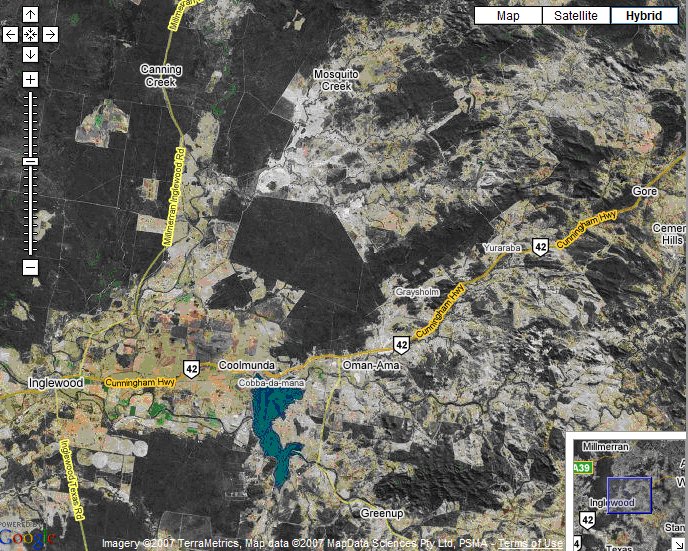
In 2011 the Inglewood Shire were kind enough to place a plaque in the cemetery with the names of the people buried there. They sent us a photo of the plaque and not long after that the cemetery was taken off the Australian Cemetery site and is now marked private as it is on private land.

The photos below show the before and after shots. The Inglewood Shire did a great job of fencing the cemetery and cleaning it up.
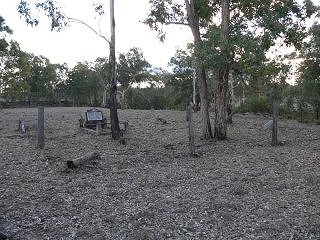 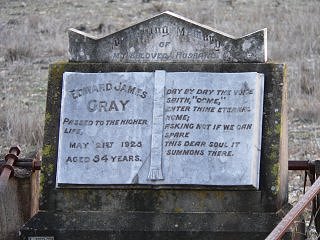
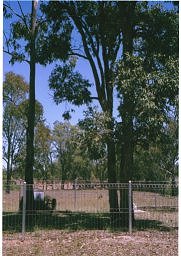 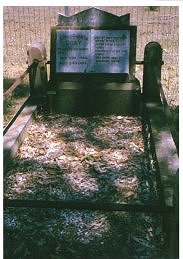 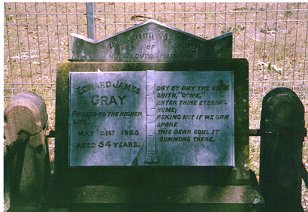
Back to William John Best Gray

The Early Years ¦
Elizabeth Gray 1803 – 1836 ¦
William Gray 1805 – 1851 ¦
Jane Gray 1808 – 1880
John Gray Jr. 1810 ¦
Hannah Gray 1813 – 1856
Ann Louise Gray 1815 – 1874 ¦
Richard Gray 1817 – 1896
Letters from Elizabeth Killett Gray ¦
Trials ¦ Trips & Ships ¦ Letters from William J.B. Gray ¦ Crest & Tartan ¦ Service Records & Stories Special Acknowledgements

Home

In the Beginning

Back to Index
|
|











